Higher education is the foundation of everyone’s dream career. Today, students have more options than just a four-year bachelor’s degree to build a better future. Driven by the rise of trade careers, trade schools are increasingly becoming the choice of many students.

About 70% of construction companies all over the country are having difficulty finding qualified workers with trade skills to hire, says The Associated General Contractors of America.
The fastest-growing occupations between 2018 to 2028 are expected to have roots in trade skills, according to recent statistics. Paying higher than average, solar photovoltaic installers and wind turbine service technicians are among the highly popular skilled trade occupations with projected growth rates of 63% and 57%, respectively.
What does this mean for aspiring students? The demand for skills trade occupations offers ample opportunities for a rewarding and fulfilling career. Students can expect to land a job as soon as they graduate, and most of these pay well.
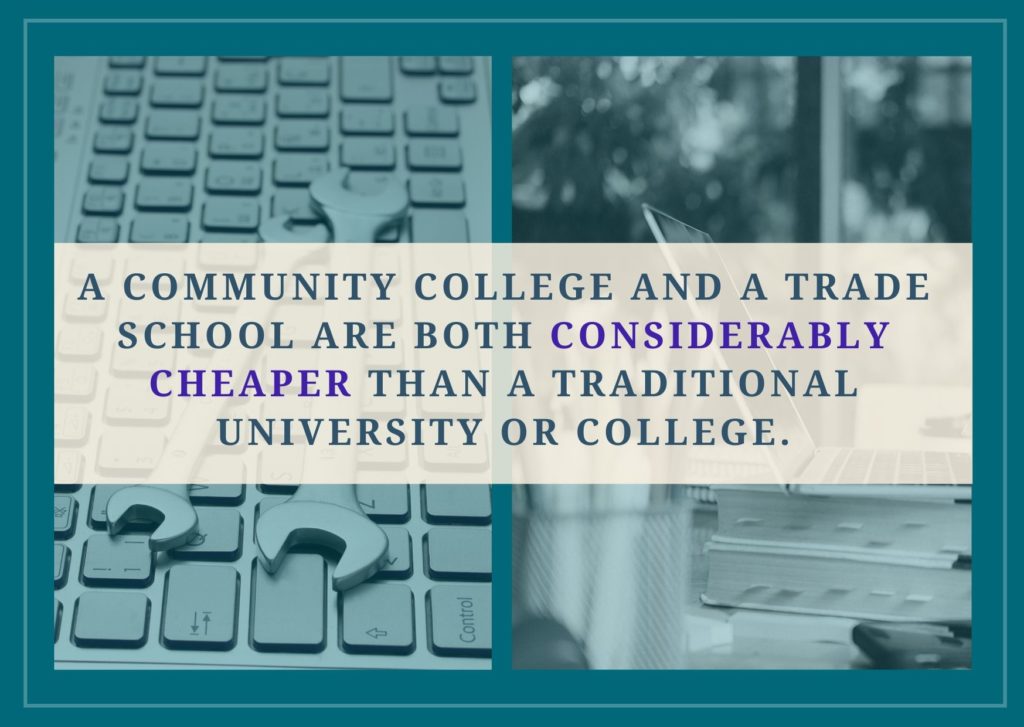
Students who wish to learn a trade can consider entering a trade school or community college. Both offer programs that can help jump-start their future careers. Trade schools and community colleges provide more affordable tuition rates, not to mention that most of their classes are also flexible enough for working adults.
This arrangement can also give them enough time to think about their options, whether it is entering the workforce after they graduate or proceeding to a bachelor’s degree in a four-year university.

What Distinguishes One from the Other?
While both trade schools and community colleges can provide a good foundation for a career in the trade, it is still ideal for getting to know what makes them different from each other. This way, students will be able to weigh their choices and settle for the best option.
Sometimes called the technical or vocational school, a trade school is an institution where students can acquire a hands-on education in a specialized career. Careers can be in the field of carpentry, woodwork, construction, plumbing, electricity, and many more.
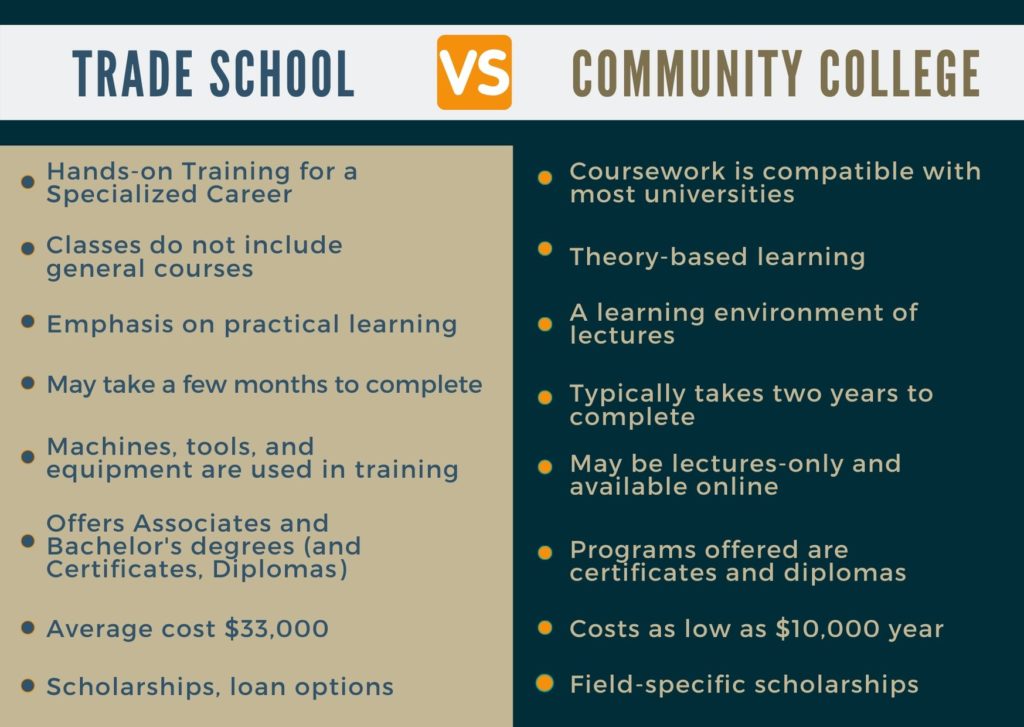
Community colleges, on the other hand, deliver a type of coursework that is compatible with that of most universities. These institutions prepare students for a four-year college.
Their differences between the two are apparent in the following fields: coursework, learning environment, length of study, method, cost, and financial aid. The following is a more in-depth take of each option.
Coursework and Program Content
Since trade schools are more specific and specialized in a chosen career field, programs offered usually do not include general courses. While it is common to have classroom lectures, most programs involve practical applications of the knowledge they have learned. This allows students to jump straight into the profession they choose, letting them complete the program at a much faster track.
Unlike trade schools, community colleges are mostly theory-based and include more lectures. Since they provide a more rounded education, students can expect to complete courses that are not entirely related to the field of their choice. This may include mathematics, communication, humanities, and even writing courses. That is why community colleges can be used as a stepping stone to a 4-year degree in other universities and colleges.
Learning Environment
As mentioned before, trade schools are more hands-on. They emphasize practical learning, encouraging the first-hand experience of the things one learns inside the classroom. The curriculum often focuses on the skills that can better prepare them for their job. Students can be sure to get their money’s worth if they are learning an in-demand trade skill.
On the other hand, students from community colleges are expected to spend a lot of time on classroom lectures as well as hands-on experience, depending on their field of choice.
Completion Time
Another obvious difference between trade schools and community colleges is the length of time that a student needs to complete the program.
While it varies on the program, trade schools usually offer certificates and diplomas that would require less than two years for completion. Some programs only require a few months to a year to complete because of the specific focus on a particular skill, making it easier and more efficient for students to get the requirements they need to land a job.
Community colleges offer programs that usually take two years to complete. However, many students take as long as four years to complete their degrees. This must be because of the extra or general courses that they need to consider before they can graduate.
Methods of Study
It is more and more common for today’s modern age to offer online classes. While there are a lot of community colleges with 100% online classes, most of the trade school programs require physical presence.
Trade schools emphasize practical learning that involves machines, equipment, and other tools that are in the school itself. Most of these are expensive and cannot be found at home. Modern and high-powered tools are housed in schools so students need to attend face-to-face classes to learn how they work. Students may also be allowed to practice their skills through on-the-job training.
There are many programs in community colleges that are fully available online. There are also options for part-time or full-time classes.
Average Program Cost
The average cost of a trade school program is $33,000. Community colleges, while slightly more affordable than most traditional colleges and universities, can still cost a lot more, usually exceeding $10,000 per year. The length of time it takes for a program to complete can also make a significant difference. Because trade school programs can be completed in two years or even less, they also cost less overall.
Program Outcomes
In community colleges, graduates can expect to earn certificates, diplomas, or associate and even bachelor’s degrees. Most of the associate programs are widely credited and can be accepted in many universities and colleges. It is not surprising that many community colleges are considered as a stepping stone for a 4-year college education.

Trade schools, on the other hand, usually only offer certificates and diplomas. It is an ideal choice for a more skills-focused nature because it provides a straightforward path to the career one wants to build upon, eliminating the need for general education units and the like.
Financial Aid
Most community colleges have available scholarships. They also have options for loans and grants from both private and public organizations. Many community colleges have the opportunity to take out student loans from the federal government.
Trade schools offer the same, but scholarships are mostly field-specific. Their programs cost considerably less as well. Many employers who want to have their workforce trained and equip them with more updated skills shoulder the cost of their trade school education. Also, it allows them a more flexible schedule to enable working students to juggle their job and school responsibilities.
In the grand scheme of things, however, either of the two is considerably cheaper compared to a traditional university or college.

Pros and Cons of Trade Schools
Trade schools are an obvious choice for many students who do not have the means for a traditional education from a college or university. Just like other conventional higher education institutions, trade schools offer various paths for a successful and promising future.
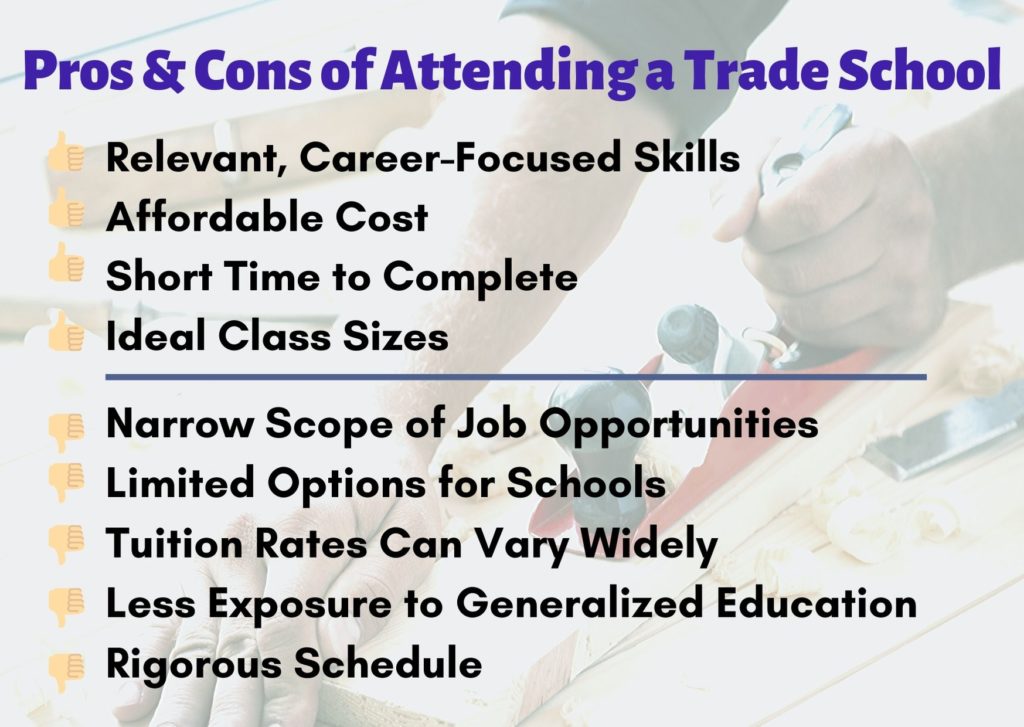
Most of them offer certificates and diplomas to students straight out of high school or working adults looking for opportunities to upgrade their skills and get certified for their respective fields. These fields include but are not limited to carpentry, graphic design, healthcare, culinary arts, and cosmetology.
Through attending trade schools, students are equipped with the necessary knowledge and skills they needed for their chosen jobs.
Trade schools have both benefits and disadvantages for many students:
PROS OF ATTENDING TRADE SCHOOLS
Relevant, Career-Focused Skills
In trade schools, students are taught practical skills that relate directly to their chosen field of interest. Apart from the classroom lectures, which are considerably less, they are provided with ample hands-on training. Most of these training opportunities take place in settings that are similar to the workplace.
Trade schools have little general education course requirements and, in most cases, none at all. Furthermore, students are also given limited opportunities for job placements after they graduate. Many employers look for individuals who have gained specialized knowledge from trade schools to bridge the employment gap.
Affordable Cost
Completing trade school programs cost considerably less than many full-time college programs. Add the chance for loans, grants, and other forms of financial aid, and the trade school cost can cost even less. Since they also require a shorter length of time to complete, students can also save a considerable amount of money. They can avoid paying for massive student loans after they graduate.
Short Time to Complete
Numerous trade school programs take two years or less to complete. Consequently, students don’t spend as much time as they would in regular colleges. Instead, they can be part of the workforce and start earning money quickly.
Ideal Class Sizes
Because trade schools usually enroll fewer students per class, classes usually have a lower teacher-student ratio. The instructors give each student a generous amount of attention. Most classes also offer flexible schedules, which means they can attend their classes in the evening or night while working a job during the day.
CONS OF ATTENDING TRADE SCHOOLS
Narrow Scope of Job Opportunities
Time restraints and a narrower field contribute to a limited scope of job opportunities for trade school graduates. Many employers give more value to college degrees since they demonstrate a capacity for a long-term commitment.
While the demand for trade school skills is high nowadays, there will come a time that the popularity of their chosen field will decline. To avoid being stuck in a low-paying career and instead pursue another, they will need to earn another certificate or diploma.
Limited Options for Schools
Unlike colleges and universities, trade schools are not as many. They also vary in focus and specialties. As a result, students have limited choices to pick from. This means students would not have much choice of quality institutions as well.
Tuition Rates Can Vary Widely
Although trade schools are generally cheaper, some institutions can cost higher than the others. Some trade schools have tuition rates that go as high as $20,000 per year. One’s residency also matters. Students who live within the state can enjoy considerably lesser tuition while those who reside out-of-state will have to pay more. Students are advised to do some research and see about the trade schools they want to enroll in to ensure quality and affordability.
Less Exposure to Generalized Education
Most traditional colleges offer general education classes like communication, mathematics, humanities, and history. Generalized education expands the student’s knowledge base and equips them with the necessary information that may be outside their field, but which may come in handy in the future. Trade schools, on the other hand, offer no such opportunities. Students miss the chance to explore generalized interests and limit their scope of learning to their chosen fields.
Demanding Schedule
Since most trade schools aim to prepare students to be part of the workforce at a much quicker time possible, students typically have rigorous coursework. Schedules-wise, they use more breaks, too. Month-long breaks between semesters that let allow them to catch their breaths are fairly uncommon. Trade school requires focus, attention, commitment, and hard work at a shorter period.

Pros and Cons of Community Colleges
Also known as junior colleges, community colleges offer significant incentives to students. It is ideal for those who want to explore their options first before committing to a 4-year university program on a schedule that works for them. This is where they can complete general courses while they weigh their options, allowing them ample time to figure out what to major in or which institution they will obtain their degree.
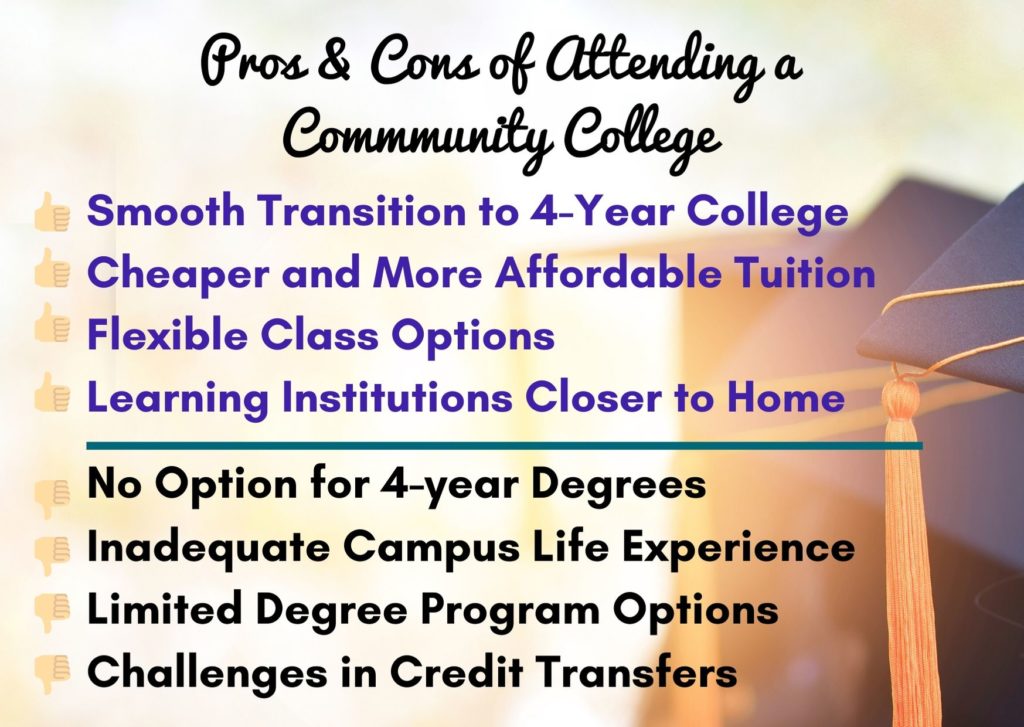
Most community colleges are more affordable than universities and colleges that offer 4-year degree programs. As a preparation for a more long-term college education, community colleges are an ideal choice. They help prepare students on a path leading to 4-year undergraduate degrees.
In the US, students can choose from more than a thousand community colleges all over the country. Interested students can weigh the pros and cons of attending one through the following:
PROS OF ATTENDING COMMUNITY COLLEGES
Smooth Transition to 4-Year College
Community colleges are known to ease the transition to college and adult life. Some high school graduates are uncertain of the best career path to pursue. While trying to decide on their career path, they can attend a community college.
This move will give them some time to grow into the idea of a four-year college. They can consider what to major in and which university to enroll. Parents do not need to worry about paying massive amounts of money when their children are still undecided about their future career path. In the meantime, students can explore their options and get their feet on the ground.
Cheaper and More Affordable Tuition
Just like trade schools, community colleges are more affordable as opposed to 4-year universities. Students can save as much as 50% or more of their educational cost in their first two years. This will buy them and their parents more time to prepare for the more rigorous financial demands that a 4-year education entails. What is more, most community colleges are accredited, which means general education courses can be transferred when students finally decided to move to a 4-year college.
Flexible Class Options
Community colleges provide a more flexible class option. Students who attend community colleges can take on part-time jobs while pursuing their education. Community colleges offer more night classes than most universities. Students also have more class schedule options with less workload.
Learning Institutions are Closer to Home
Most states have their community colleges, giving easy access to students who want to pursue their higher education. Attending one in the local area will cut down costs on transportation and housing. This arrangement also allows them to fit their classes with their schedules. They can take on a part-time job in their locality and attend their classes at the same time.
CONS OF ATTENDING COMMUNITY COLLEGES
No Option for 4-year Degrees
While most community colleges can help one transition to a 4-year university, it is, unfortunately, a means to get one halfway there. To acquire a 4-year education, students need to go to an accredited 4-year university or college. Community colleges are mostly designed to provide two years of instruction that can be used for a 4-year undergraduate degree in another institution. Most of the options are for specific certifications in many vocations that are integral for job advancements.
Inadequate Campus Life Experience
Most community colleges allow students to fit their education around their life; hence campus life is not a priority. While there are opportunities to take part in athletics, organizations, and clubs, they are not integrated into campus life. Students who prefer an energetic social atmosphere will find attending a community college lacking.
Limited Degree Program Options
Students who want to explore many options for majors will find that community colleges have more limited scope compared to 4-year institutions. Most local community colleges only provide a handful of degree options to choose from, usually offering those that lead to more popular occupations. Specialized classes are sadly not as common.
Credit Transfer Challenges
While most colleges and universities accept transfer credits from community colleges, there are cases when one encounters difficulty in doing so. Often, this happens when students go out of state or fail to acquire an associate degree. Their credits might not translate as well to some 4-year universities. In most cases, they might be required to retake some of their classes or go through an exam. There are also limits to transfer credits, with 90% credit transfers allowed at most.

3 Top Trade Schools in the U.S.
Universal Technical Institute
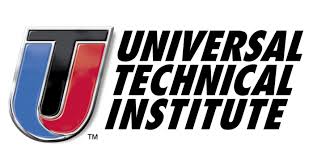
Known as the leading provider of training for automotive programs for 53 years, the Universal Technical Institute is one of the best choices for students who want to earn a certificate or diploma in their chosen skills-trade field. This educational institution spreads out to 12 campuses all over the country, with three campuses found in California.
Showcasing state-of-the-art industry facilities, strong partnership with industry leaders, and excellent training that align with the requirements of employers, students can be sure to acquire and gain knowledge and skills that are integral to their interests and field. They can be assured to be better trained and prepared before joining the workforce.
Students can expect hands-on training at a faster pace, allowing them to earn money within a year or less. The school has a strong relationship with many employers from significant manufacturers, dealerships, and local shops.
Their programs vary and are known for their quality education. Students can learn automotive technology, diesel technology, and welding technology, among many others.

Brownson Technical School
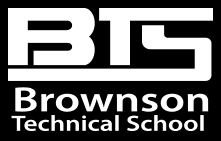
Brownson Technical School, located in Anaheim, California, is rooted in the back shop of Don Brown’s business in 1984, an HVAC and appliance repair instructor who shared his rich experience in the field to aspiring students.
With the help of his son, Don Brown has developed and built a course with integrated hands-on training, enabling students to learn a highly technical career in a shorter period. The school has earned a reputation for excellence in the HVAC vocational industry. They offer two HVAC programs to students: one for those who want to learn the skills of HVAC Technician, and the other is a pathway for HVAC certification.
Another distinction of Brownson Technical School is its offer of DDC (Direct Digital Controls), computerized control for industrial, commercial, and home installations. It is one of the knowledge and skills valued by employers looking for trained and certified HVAC technicians.
In Brownson, students can be assured of quality education and training that can help them land meaningful careers and employment in the field of HVAC. They offer a competency-based approach to teaching, providing students with the same level of excellence as they progress through their careers.

HVAC Technical Institute
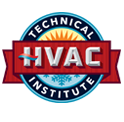
Students shifting career paths or strengthen their existing skills in HVAC can consider attending HVAC Technical Institute in Chicago, Illinois. This technical school focuses on training and preparing students by equipping them with practical skills that can be applied in air conditioning, ventilation, and heating workplace.
The school provides personal instruction that significantly helps students to learn at different speeds. They limit their class sizes to 20 students per instructor, ensuring that students will be able to receive ample training that they need to succeed. Upon graduation, students can receive R-410A safety certification and an EPA section 608 universal license. These certifications are integral in providing them with skills to work and build a career as soon as they leave the school’s doors.
Student education at HVAC Technical Institute, however, does not end when one acquires certification. To stay up-to-date in the skills game and upgrade their competencies can always enroll back in one of their previously completed HVAC classes.

3 Top Community Colleges in the U.S.
Lake Area Technical Institute

A private, non-profit school, Lake Area Technical Institute is located in Watertown, South Dakota. In 2017, it was awarded Aspen Prize for Community College Excellence. It has a large variety of specializations, all of which can be accomplished in two years.
The distinctive technical education offered by this community college helps students land a job in a high-demand career field. The programs are cutting-edge, equipping them with highly qualified skills and training needed for their roles in the workforce. As leaders in technical education, the school integrates the latest technology and methods in delivering quality education to meet global workforce demands. It is accredited by the Higher Learning Commission.
Some of their choices include disciplines in the field of agri-business, agri-production, commodity merchandising, energy technology, aviation maintenance, high-performance engine machining, human services technician, law enforcement, community healthcare, cosmetology, diesel technology, and many more.

Columbus Technical College
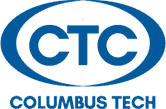
Opening its doors in 1961, Columbus Technical College is one of the three technical schools in Georgia to pilot engineering technology programs when it offered an Associate Degree in Applied Technology. Every academic year, the college enrolls nearly 5,000 students. They award associate degrees, diplomas, and technical certificates, boasting job placement rates in the 95% range.
With more than 100 academic programs of study, Columbus College helps students gain valuable hands-on experience and skills that can strengthen their capabilities for a successful future. Some of the courses and programs on offer include Air Conditioning Technology, Automotive Collision & Repair, Automotive Technology, Carpentry and Cabinetmaking, Dental Hygiene, Drafting Technology, Cosmetology, Welding, and Major Appliance Repair and Technology.

Walla-Walla Community College
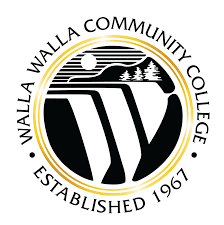
Located in southeastern Washington, Walla-Walla Community College serves as the educational and cultural hub in the region. Currently, the college enrolls 13,000 students for the academic school year.
In this educational institution, students can earn degrees and certificates in 20 different fields, including in the Liberal Arts and Sciences, Healthcare, General Studies and Humanities, and Mechanic and Repair Technology.
Students also get financial aid options. Roughly 40% of undergraduate students at Walla-Walla Community College received grants or scholarships. The school also offers an open admissions policy and credit for life experiences.
